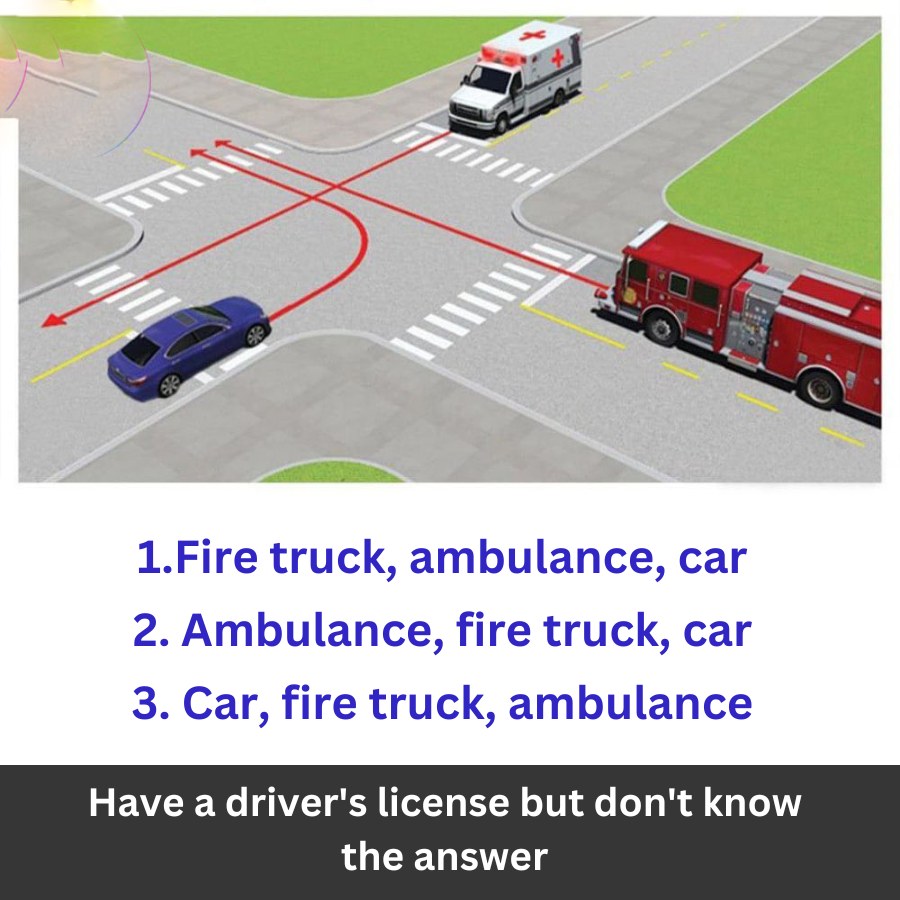Driving is a crucial skill in today’s fast-paced world, and a driver’s license is often considered a rite of passage for many. It’s a document that not only symbolizes independence but also serves as proof of your ability to operate a vehicle safely. However, possessing a driver’s license doesn’t always mean you know all the rules of the road—or even the answers to some seemingly simple traffic-related questions. Let’s dive into a question that has left many scratching their heads:
What is the correct order of priority when an emergency vehicle, such as a fire truck, ambulance, and a car, needs to pass through an intersection?

The Answer: Fire Truck, Ambulance, Car
Yes, that’s the correct order. Emergency vehicles like fire trucks and ambulances always take precedence on the road due to the critical nature of their operations. But why is this the case, and why do so many licensed drivers struggle to answer such questions? Let’s explore the reasoning behind this hierarchy and why it matters for everyone who shares the road.
Understanding the Priority
Emergency vehicles operate under the principle of saving lives and minimizing damage. Fire trucks, for example, are often rushing to extinguish fires that could quickly spiral out of control and cause extensive harm to both people and property. Ambulances, on the other hand, are on their way to transport patients in critical condition who need immediate medical attention. Finally, regular vehicles, like your car or mine, come last in this line of priority because they typically don’t involve life-or-death situations.
The law dictates that when an emergency vehicle approaches, drivers must pull over to the side of the road and allow them to pass. But within the realm of emergency vehicles themselves, the fire truck is given the highest priority. This is because fires, if not addressed promptly, can cause widespread devastation. Ambulances are next, as medical emergencies are time-sensitive but often have a slightly longer window for response compared to fires.
Why Do Drivers Get It Wrong?
Many licensed drivers fail to answer this question correctly, and the reasons vary. Some might not recall learning about it in their driver’s education classes, while others may never have encountered this situation in real life. Additionally, the stress of driving in heavy traffic can make it difficult to think clearly about such scenarios.
Another factor is that traffic laws and driving norms can vary by region, leading to confusion. In some areas, specific signals or rules dictate the movement of emergency vehicles, and drivers may struggle to keep up with the variations.
The Importance of Knowing the Rules
Understanding the correct priority for emergency vehicles isn’t just about passing a test or avoiding fines. It’s about contributing to a system that allows these vehicles to perform their life-saving duties effectively. When drivers are unaware of the rules or hesitate to act, they can delay an emergency response, putting lives at risk.
For example, if a fire truck is delayed in reaching a burning building because drivers failed to yield properly, the consequences could be catastrophic. Similarly, if an ambulance carrying a critically ill patient is stuck in traffic because drivers are confused about the right-of-way, the patient’s chances of survival decrease.
A Reminder for All Drivers
Whether you’re a seasoned driver or someone who just passed their test, it’s essential to refresh your knowledge of traffic rules periodically. The roads are shared spaces, and understanding how to navigate them responsibly is crucial for everyone’s safety.
If you ever find yourself unsure about what to do when an emergency vehicle approaches, remember this simple hierarchy: fire truck, ambulance, car. Pull over to the side of the road and wait until the emergency vehicle has passed. Your quick and decisive action could make all the difference in an emergency.
The Bottom Line
Having a driver’s license comes with responsibilities that go beyond just knowing how to operate a vehicle. It’s about being an informed and considerate driver who contributes to the overall safety and efficiency of the roadways. Understanding the priority of emergency vehicles is a small but significant part of this responsibility.
So, the next time you see flashing lights and hear the wail of a siren, don’t panic. Just remember: fire truck, ambulance, car. Yield appropriately, and know that your actions are helping save lives.
This version maintains the original meaning while expanding on the importance and context of the scenario to meet the word count requirement and appeal to an American audience.





